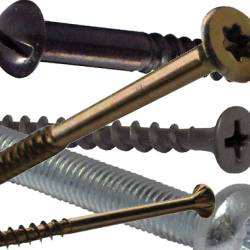What Is The Difference Between Screws And Bolts?
For any type of DIY or construction application – for example putting together some flat-pack furniture or a shelving unit – you will need a type of fastener, or a combination of fasteners. What you need very much depends on the materials you are using, the load requirements of the item and the location of what you are putting together. Bolts and screws are standard types of fastener, and there are many different types of each. But there is also an ongoing debate about which is the better fastener, and what advantages and disadvantages each type of fastener presents.
In truth, there is no definitive answer about which is better, because each one has different qualities for different applications. To the naked eye, screws and bolts look very similar, but it is important that you make the right choice for the application you are undertaking. So let’s first understand what each one is and then we can explain what the key differences are.
What are screws?
Screws are a versatile and very popular type of fastener. They come in various shapes, lengths and types and are used for creating a secure hold when joining together woods, metals, plasterboard and even concrete. Screws are self-tapping, which means they make their own hole in the material you are working with, when they are driven into it.
A screw is made up of a head which can be flat or domed, and usually has a slot or a cross in the head, which dictates the type of screwdriver you would need to drive it into a material. Then there is a shank, which has a helical groove wrapped around it called the thread. The thread will mate with the material it is driven into to create a secure hold. So it will mate with an existing thread, or it will create its own.
What are bolts?
A bolt looks very similar to a screw in that it has a shank attached to a flat or domed head. Again there are many different types and sizes which are generally applicable to the type of material you are working with. A bolt can also have a thread, like a screw, but sometimes it doesn’t have a thread at all, apart from at the very end. Instead, a bolt provides strength and security by using a nut. The nut is screwed over the end of the bolt to secure it in place, in some cases there will also be a washer, located in place before the nut is secured, which acts to spread the load over a larger surface area and therefore provide added stability.
What are the key differences between screws and bolts?
- Bolts are considered to provide a stronger hold than a screw, because of the nut and washer system they use. So a bolt is probably better for heavy duty applications such as machinery or shelving, and where vibration or movement is expected, because the nut acts to minimise the effects of the movement and prevent loosening. This reduces wear and tear on the bolt also.
- Bolts are usually pushed through a drilled hole in a material and require a wrench to secure the nut because it requires torque. The same torque in reverse will remove the nut. A screw however, needs a screwdriver to install it, usually with a pilot hole, and then the screwdriver will drive the screw through the material.
- Screws usually have a pointed end to help the self-tapping drive, while bolts have a flat end.
- Bolts are typically easier to remove than a screw, because there is less thread. Once the nut is removed, the bolt should pull out, however, a screw needs to be driven out in reverse because of the thread, which can be a longer job.
- Screws are good for low to medium duty applications, such as working with wood, plasterboard or sheet metal.
- Screws will be shorter in length than the width of the material you are driving into, because you don’t want the screw to protrude from the other side. However, bolts will be longer than the width of the material you are driving into, because you need the end of the bolt to protrude from the other side sufficiently to secure the nut on the end. If you are using a washer also, you need to allow for the thickness of this as well.
- Screws are usually fully threaded, which gives them their strength and hold, while a bolt will only be partially threaded, sometimes only at the end. The unthreaded section of a bolt’s shank is what provides the shear strength.
- If you browse our selection of screws and bolts at MB Direct, you will see that screws can vary in material. They can be stainless steel, brass or black, while bolts are typically just stainless steel.